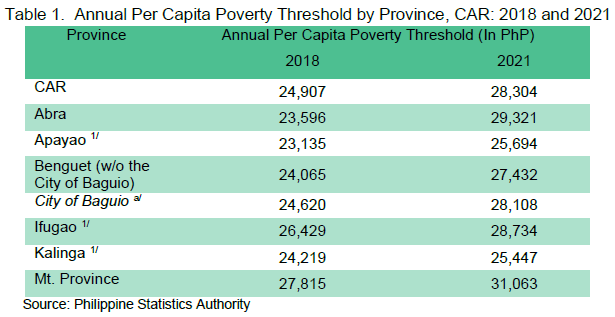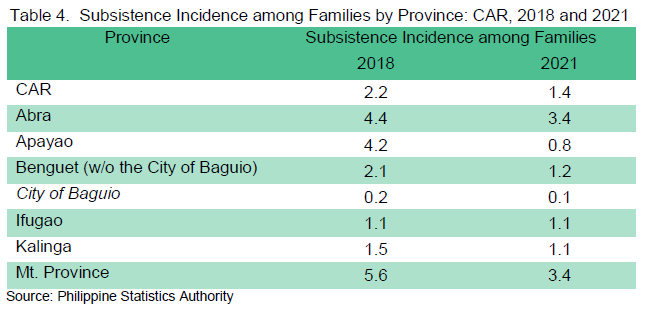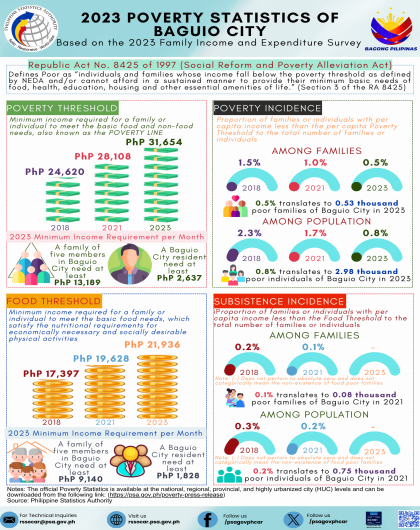The results of the Family Income and Expenditure Survey (FIES) in conducted 2021 are the main source of data for the estimation of the 2021 Full Year Official Poverty Statistics of the Philippines. The FIES is a nationwide survey of households undertaken every three years. It is the main source of data on family income and expenditure, which include among others, levels of consumption by item of expenditure as well as sources of income in cash and in kind. The results of FIES provide information on the levels of living and disparities in income of Filipino families, as well as their spending patterns.
Mountain Province’s poverty threshold at PhP 31,063
- Mountain Province had the highest poverty threshold among provinces in CAR at PhP 31,063 in 2021. This was an increase of 11.7 percent from 2018 Full Year Poverty Statistics.
- Abra recorded the second highest poverty threshold at PhP 29,321, an increase of 24.3 percent from the PhP 24,907 poverty threshold posted in 2018. The province also experienced the highest increase in poverty threshold among provinces in CAR.
- Kalinga had the lowest poverty threshold at PhP 25,447. A slight increase was recorded from 2018 poverty threshold of PhP 24,219.
Mountain Province records highest per capita food threshold at PhP 21,774
- Food threshold is the minimum income required for a family or individual to meet the basic food needs and satisfy the nutritional requirements set by the Food and Nutrition Research Institute (FNRI) for them to be economically and socially productive. If the income of the individual or family falls below the food threshold, they are considered subsistence poor or food poor. They are also called poorer than poor since they could not provide for themselves adequate sustenance to carry out productive activities.
- Same with poverty threshold, Mountain Province posted the highest food threshold in 2021 with PhP 21,774.
- This was followed by Ifugao with PhP 20,504 estimated food threshold in 2021. This was an increase of 10.0 percent from PhP 18,447 estimated food threshold in 2018.
- On the other hand, Apayao posted the lowest food threshold with PhP 17,942. This was, however, 10.0 percent higher than PhP 16,155 food threshold of the province in 2018.
Highest poverty incidence among Families in Abra
- Based on the 2021 Full Year Poverty Statistics, the proportion of poor families in most of the provinces in CAR decreased from the 2018 Full Year Poverty Statistics.
- Across provinces, Abra had the highest poverty incidence with 15.8 percent. It posted an increase of 1.1 percentage point from 14.7 percent in 2018.
- Kalinga, Apayao and Baguio City posted the lowest poverty incidences with 5.6 percent, 4.7 percent, 1.0 percent, respectively.
- Comparing the 2018 and 2021 poverty statistics, Ifugao and Kalinga had the biggest decline on the proportion of families with differences of 3.9 and 3.6 percentage points, respectively (Table 3).
Food poor families in Apayao declines the most in 2021
- The subsistence incidence among families in CAR was highest in both Abra and Mountain Province with 3.4 percent. On the other hand, Baguio City posted the lowest proportion of food poor families with 0.1 percent in 2021 from 0.2 percent in 2018.
- Across provinces and highly urbanized city (HUC), only Ifugao posted an increase in the proportion of food poor with 0.01 percentage point increase from the recorded 1.11 percent in 2018.
- Apayao recorded the highest decline in the proportion of food poor families from 4.2 percent in 2018 to 0.8 percent subsistence incidence among families in 2021.
Technical Notes
Family
a group of persons usually living together and composed of the head and other persons related to the head by blood, marriage or adoption. It includes both the nuclear and extended family.
Family Expenditures
The expenses or disbursements made by the family purely for personal consumption during the reference period. These include: - Total value of all items of consumption/expenditure bought on credit during the reference period as well as services availed of within the same period that have not been fully paid at the time of visit. - Value consumed from gifts, support, assistance or relief in goods and services received by the family from friends, relatives and imputed rent of owner-occupied dwelling unit. '- Gifts, support, assistance or relief in goods and services donated by the family to friends, relatives and others like tithes, contribution to church, etc. - Imputed value of goods/ services received as fringe benefits from employer or part of the salaries/wages of employed family members.
Family Income
The primary income and receipts from other sources received by all family members during the reference period, as participants in any economic activity or as recipients of transfers, pensions, grants, interests, food and non-food items received as gifts by the family. Primary income includes: - Salaries and wages from employment - Commissions, tips, bonuses, family and clothing allowance, transportation and representation allowance and honoraria - Other forms of compensation and net receipts derived from the operation of family-operated enterprises/activities and the practice of a profession or trade Income from other sources includes: - Imputed rental values of owner-occupied dwelling units - Interests - Rentals including landowner’s share of agricultural products - Pensions, royalties and dividends from investments - Gifts, support in any form (physical, material and financial) and the value of food and non-food items received as gifts by the family (as well as the imputed value of services rendered free of charge to the family). - Cash received out of salaries/wages and other sources of income of a family member who is a contract worker abroad and also cash receipts sent by a family member/relative of the household with a status of residency abroad other than that of a contract worker - Receipts from family sustenance activities, which are not considered as family operated enterprise.
Food threshold (FT)
the minimum income/expenditure required for a family/individual to meet the basic food needs, which satisfies the nutritional requirements for economically necessary and socially desirable physical activities.
Poverty incidence (PI)
the proportion of families/individuals with per capita income/expenditure less than the per capita poverty threshold to the total number of families/individuals
Poverty threshold (PT)
the minimum income/expenditure required for a family/individual to meet the basic food and non-food requirements
_____________________________________________________________________________






